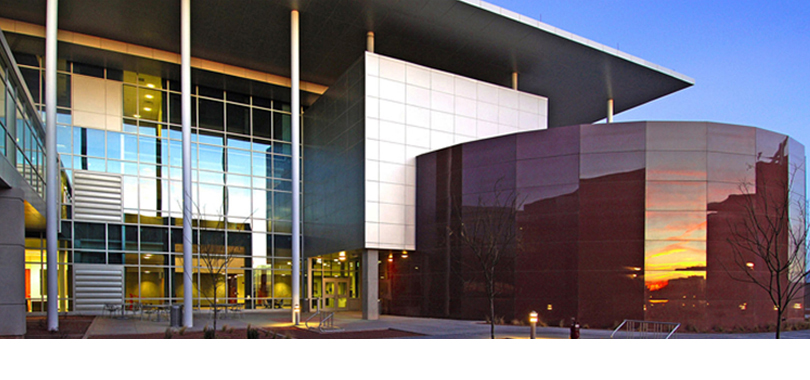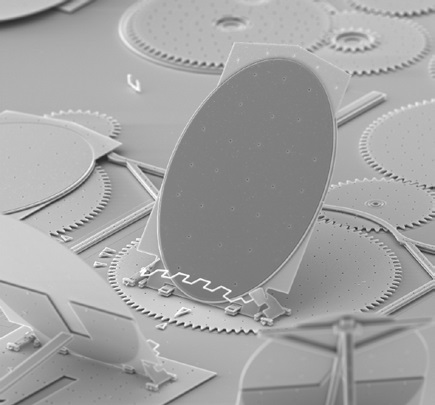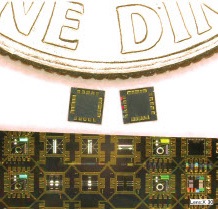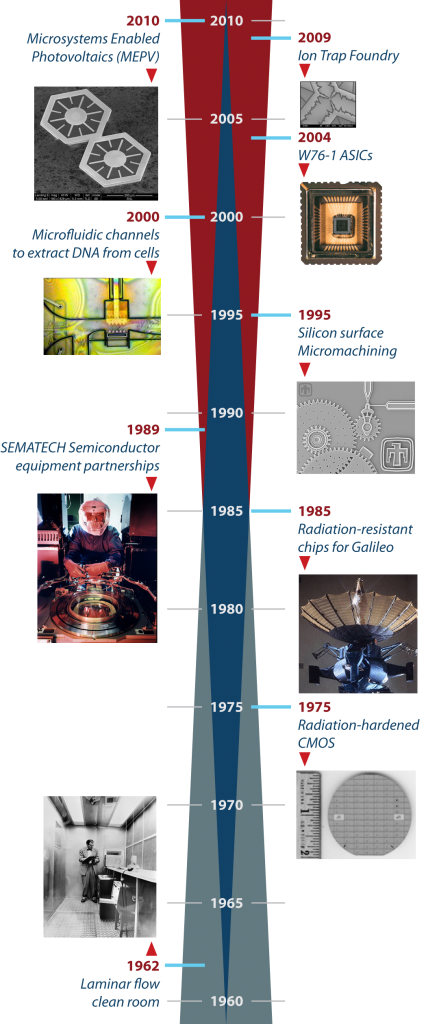Microsystems Engineering, Science and Applications (MESA)
MESA Makes It Real
The Microsystems Engineering, Science and Applications (MESA) Complex represents the essential facilities and equipment to design, develop, manufacture, integrate, and qualify microsystems for national security needs that cannot or should not be made in industry— either because the low volumes required for these applications are not profitable for the private sector, or because of stringent security requirements for high-consequence systems.

Microsystems extend the information processing capabilities of silicon integrated circuits to add functions such as sensing, actuation, and communication—all integrated within a single package. The MESA Complex integrates the scientific, engineering, and computational disciplines necessary to produce functional, robust, integrated microsystems. This suite of facilities encompasses approximately 400,000 square feet and includes cleanroom facilities, laboratories, and offices, and represents at the center of Sandia’s investment in microsystems research, development, and prototyping activities.
Beyond Microelectronics: Integrated Microsystems


MESA continues to pioneer new technologies that have impact on the nation: Sandia’s Microsystems Enabled Photovoltaics (MEPV) “Solar Glitter” uses microdesign
and microfabrication techniques to produce solar cells as small as 3-20 microns
thick and 100- 1000 microns wide. Moving to micro-scale PV cell sizes results in
distinct benefits at cell, module, and system levels, including reducing the amount of expensive semiconductors by 30 times while still achieving high efficiencies.
MESA Continues Sandia’s Long Tradition of Delivering Custom National Security Hardware
The Sole Supplier
Sandia has developed and delivered custom, radiation-hardened microelectronics to the nuclear stockpile and other national security customers since 1975. Sandia-built integrated circuits have assured that our nuclear deterrence could not be defeated by hostile nuclear environments from potential adversaries maintaining the safety, security, and use control of our nuclear stockpile.
Beyond its support for the nuclear stockpile, Sandia provides microelectronics and microsystems for satellite payloads that monitor the earth for non-proliferation activities, specifically the Global Nuclear Burst Detector that flies on Global Positioning Satellites (GPS). MESA provided the first fully space-qualified MicroElectroMechanical Systems (MEMS) to control the temperature of nanosatellites while functioning in the radiation of space.
MESA continues Sandia’s long tradition of developing and delivering custom national security hardware. Sandia has been awarded 40 microelectronics and microsystems related R&D 100 Awards since 1986.
Emerging nano technologies are transforming microsensor research and development, a key enabler of Sandia’s national security mission. By emphasizing handheld and autonomous technology, Sandia is developing novel biological and chemical microsensor technologies across a range of technical maturity that has applications for numerous federal agencies and commercial partners.

Sandia’s microresonators are miniature acoustic resonators fabricated using complementary metal-oxide semiconductor (CMOS)-compatible microfabrication techniques. When grouped together, our microresonators operate as filters: they provide frequency selection in radios and other electronic equipment. When connected with transistor electronics, microresonators can provide frequency reference functions (such as clocking) to radios, microprocessors, and other electronic devices.
In partnership with industry, Sandia contributed significantly to the development of a chip-scale atomic clock, with the goal of transforming atomic clocks from laboratory rack-mounted instruments to low-power, handheld devices that could be carried by a soldier to enable jam-proof communication and precision navigation in GPS-denied environments.
Microelectromechanical system (MEMS) sensors, including accelerometers, gyroscopes, pressure sensors, and microphones, have become a multi-billion dollar market in consumer electronics, automobile, and industrial applications. Sandia helped lay the foundation for these sensors in the 1990s. Today, Sandia fills niches in national security, where commercial devices are not available because the technology is too immature or the market is too small.
Sandia also is engaged in research in quantum physics based devices. MESA has developed techniques for microfabricating ion traps that are being used by researchers worldwide to conduct research on quantum systems for sensing, precision timing, and information processing.
The benefits of MESA extend beyond mere hardware. As Tom Hunter’s vision stated, a key aspect of MESA is to entice and invigorate some of the nation’s best scientific and technical talent to apply their skills to the esoteric needs of national security. The partnership between DOE’s Center for Integrated Nanotechnology (CINT) and MESA is a prototype for bringing leading-edge capabilities to the service of our nation’s security.